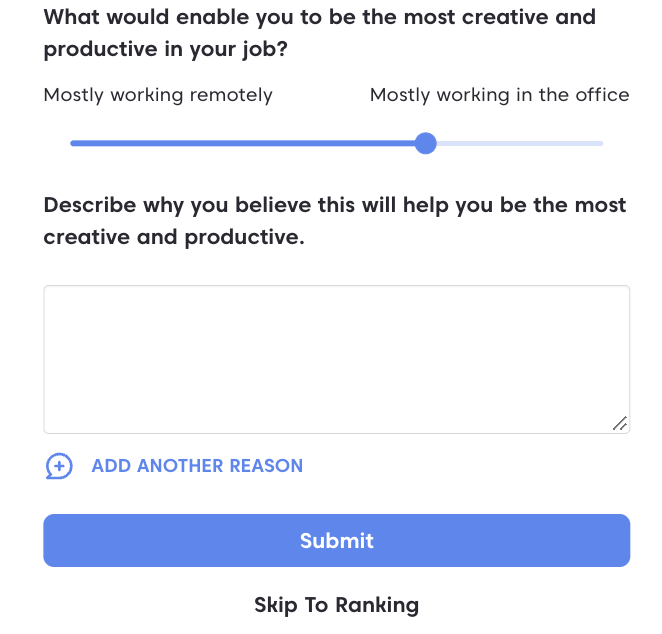Contact Us for a Demo


Breaking the Barriers to Productive Work | Part 2
An AI that facilitates and predicts the results of our collaborations
To change the calculus of collaboration, we need to replace serial listening with a dynamic parallel listening process. The process embraces interaction and focuses on collective reasoning: how the group reasons together to predict an outcome or prioritize the important next steps. For those who want to go deeper, I refer you to a couple of prior articles².
To change the calculus of collaboration, we introduce a new type of social conversation based on collective reasoning (a combination of collective intelligence and AI). The AI functions as a super-intelligent facilitator whose job it is to:
- Guide the discussion towards the desired outcome (e.g., a list of priorities or decision prediction accurately representing the group’s collective intelligence).
- Listen to everyone generously and equally, capturing the “whys” and evidence in their reasoning.
- Encourage the exchange of ideas and learning areas of alignment by sampling and getting feedback from others’ ideas.
- Drive the discussion to a conclusive outcome by learning areas of agreement.
- Record every interaction and result into a computational knowledge model open to inference, query, and simulation.
CrowdSmart’s AI (or simply CrowdSmart) produces a predictive model from collaborations. The model dynamically distills the collaboration results in real-time producing:
- A prioritized list of the relative importance of ideas supported.
- A representative voice of the group’s opinion or reason for a decision/prediction.
- Recommended actions with explanations.
Getting to the hearts and minds of working teams
We return to the problem posed in the introduction. How do we learn the hearts and minds concerning some proposed outcome? Let’s first focus on what is the right question to ask. We assume both C-level and employees are focused on maximum creativity and productivity. The CEO wants a highly creative and productive team aligned with company mission values and performance so that the company’s business performance and rating as a great place to work are excellent. The employee wants to gain professional development and compensation for being a productive and creative employee. Thus we focus the question on a mutually desired outcome.

At one end of the scale, the participant can select “Mostly working in the office.” At the other end of the scale, “Mostly working remotely.” If we want to get to their “hearts and minds,” we want to know the reasons for their point of view. For generous listening, we want participants to articulate why they believe they will be more productive at any point of the spectrum. This first interaction is unaided. The participant is focused only on the “why” that caused them to register a specific score. For those familiar with design thinking, this step in the process is reaching for the “five whys.”
The participant submits their reasons for their score. The system records their prioritized list and updates the knowledge model. The proprietary intelligent sampling algorithm orchestrates the interaction with peers. The sampling algorithm combines hypothesis testing (e.g., what are the reasons rising in relative importance) with discovery.

We often get new ideas by interacting with others. We find out what we didn’t know we didn’t know. The interaction is dynamic. New ideas create the potential to change the outcome radically. The author’s identity is masked to reduce bias and encourage open thinking. The sample idea list is short, making it possible to read each. Another sample idea list is available if you do not see anything you align with. Much of the intelligence that learns alignment is in the (patented) sampling algorithm. In the display above, the participant has selected some items that align with their thinking and put them in priority order from their point of view. Prioritization is important because we want to know what is most important to them. Prioritization allows the system to learn aligned priorities and beliefs. Establishing priorities in social or economic choice is foundational to accuracy in prediction.
As in any collaborative process, synergistic generation of new ideas is a highly desired outcome. As the participant reviews comments, they can click on the light bulb and enter their idea. This is similar to any facilitated collaboration session but has two key benefits: 1. Bias is reduced by masking identity, and 2. The process is asynchronous, allowing engagement and creativity to happen anytime, anywhere.
The social collaboration described here is akin to a virtual workgroup at scale. The conversation is asynchronous, and the author’s identity is masked to reduce bias and encourage transparency. The AI learns economic preferences or social choices at scale ( the law of comparative judgment, the A/B test delivered at scale).



